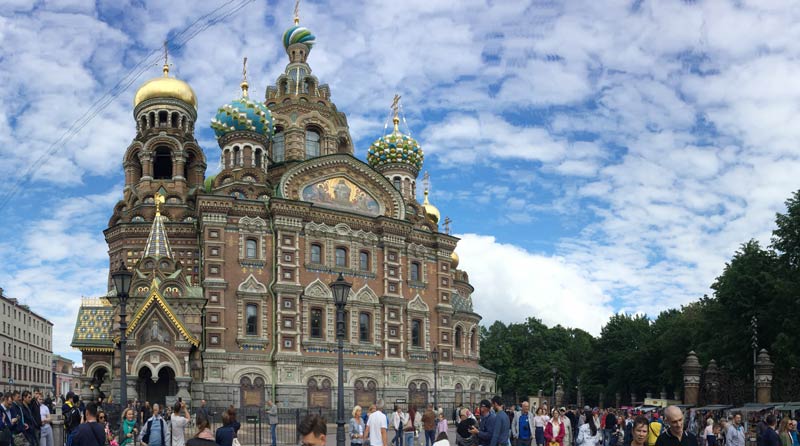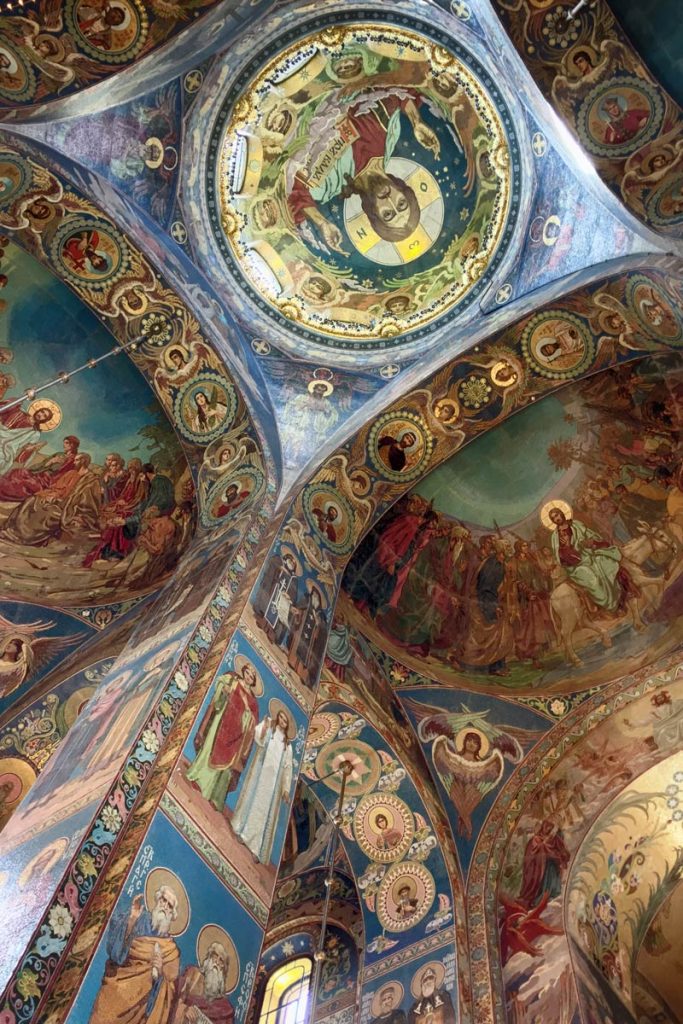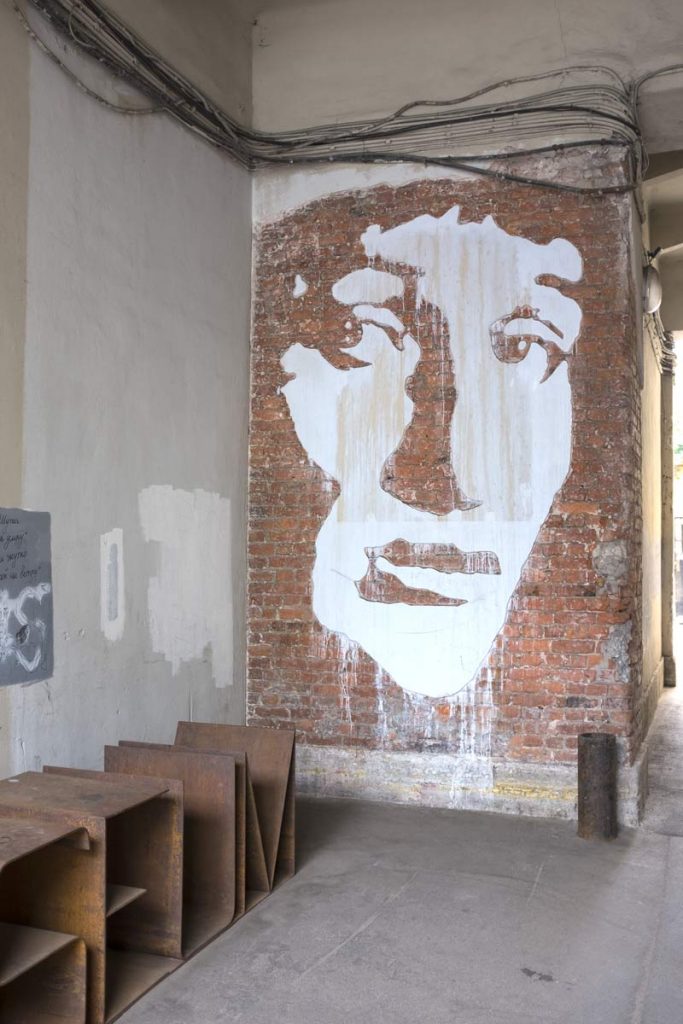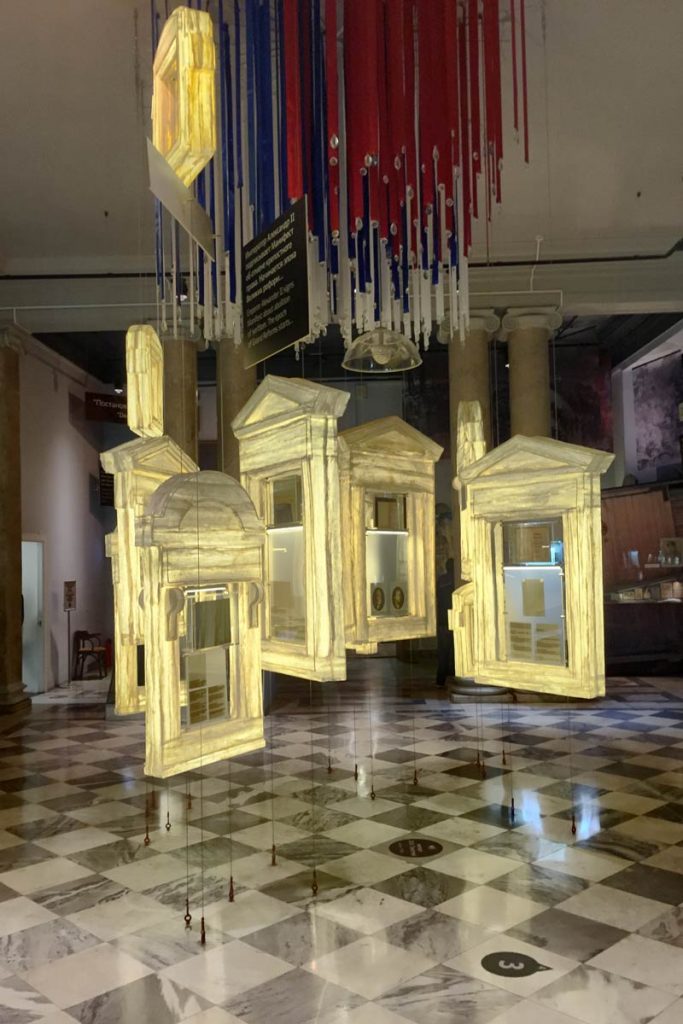
We queue for tickets and go into the Church of The Spilled Blood. There’s a monument inside marking the spot where Alexander II was assassinated.
As I explained in Part I of this diary, assassins threw a bomb at his armoured carriage and succeeded only in hurting some people who were nearby. Alexander got out of the carriage to see what was going on and the second bomb killed him. And now there is this church to mark the spot.
We wonder what caused him to get out of the carriage. The reports suggest that he just didn’t think he could be hurt. We wonder whether the contemporary reports are accurate. Did something else happen?
Every surface of the interior of the church is decorated with highly-coloured scenes made from tiny pieces of marble.

Anna Akhmatova Museum
We go to the Anna Akhmatova museum (more about Anna Akhmatova to follow in a later post) where this image is on a wall in the alleyway leading to the museum.
The alley itself gives a flavour of how not everything in Saint Petersburg is well renovated. We think it is not a matter of care but of a lack of money.

The Museum of Russian Political History
And then to the Museum of Russian Political History. The layout is more imaginative and impressionistic than we imagined such a museum would be.
The room in this photo covers the period of the Alexanders leading on to the Russian Revolution.

It is a State museum and we expect the criticism (if any) of the Stalinist era to be mild. In fact, it is highly-critical.
I take scans of the descriptions written on the walls, and convert the text to readable text so that I can post it here. At the entrance to the rooms covering the Stalinist era there is this:
The Soviet Epoch: Between Utopia and Reality 1917-1953 – Dear Visitor!
The hall you entered is a labyrinth, a kind of corridor of power, in which almost no room is provided for human freedom. We suggest you to pass it in order to compose the ‘portrait’ of the Stalin’s political regime, defined by historians as totalitarian.
During Stalin’s epoch the Bolshevik’s policy was characterised by ultimate centralisation of management, dictatorship of the Communist party and its ideology and complete disparity between slogans and reality.
Radical reforms in economy and society were carried out with repressive methods, corresponded by unacceptable
rates of growth of standards of life and almost total ignorance of all human rights.Museum exhibits and images of those times life provide an understanding of the essence of Stalin’s rule, of its objectives and methods. The State’s directives interfered in personal lives and subordinated them to a firm control of culture and social life. Witnesses of the past will show you how people treated the decisions and actions of the authorities and, most importantly, how they lived in those conditions.
Both the utopia of a ‘happy future’ and ‘reality-heroic’ and the tragic simultaneously-intertwined closely, creating ‘the Soviet style of life’.
Journey along the labyrinth will show you that the gap between declared ideals and practice became wider with every period of the USSR development.
The more became this gap, the more massive became the intervention of ideology in all spheres of life.
Stalinism both before the second world war and up to Stalin’s death in 1953 was based on preventive terror and repression as well as excluding any forms of pluralism in ideology and policy.
Viewing the exhibition will be accompanied with songs, which at that time were sounding every day. Major, stately and lyric – they stated heroics of the daily-life of building socialism and the actual achievements of Soviet people, but at the same time thrust on people the image of life different from reality.
The Recent Past
We absorb the criticism of Stalinist Russia and expect that the modern era will be treated more kindly. But no, there are equally critical words for the 1990s.
21st September 1993
Moscow. President of the Russian Federation Boris Yeltsin issues a decree ‘On Gradual Constitutional Reform’, suspends the Supreme Soviet of the Russian Federation and calls for elections to the new legislative body, the State Duma. The Supreme Soviet considers Yeltsin’s move as a coup-detat…Yuri Nesterov, a delegate at the 10th (Emergency) Congress of People’s Deputies of Russia on September 23, 1993, claims in his speech that the barricade that divided the society into advocates of economic reforms and advocates of a law-based democracy has grown higher today. This incongruous and at the same time tragic barricade represents a new wound that will take a long time to heal.
16th June 1996
The first round of the Russian presidential elections. Pre-election spin technologies are applied on a mass scale. Big business and oligarchs pay for the presidential election campaign ‘Vote or Lose!’ Boris Yeltsin’s rating grows from 5 to 35%…Gennady Zyuganov, one of the presidential candidates, writes in his memoirs (1996) that few were expecting such a total ‘brainwashing’ from the mass media or fierce pressure from the local governments. The ruling regime succeeded in implanting a barrier of fear in millions of Russian voters making them indifferent to the Communist Party’s call for redeeming basic social values: justice, honesty and solidarity.
It is strange to be in Russia and read that “justice, honesty and solidarity” are left in the dust of history.